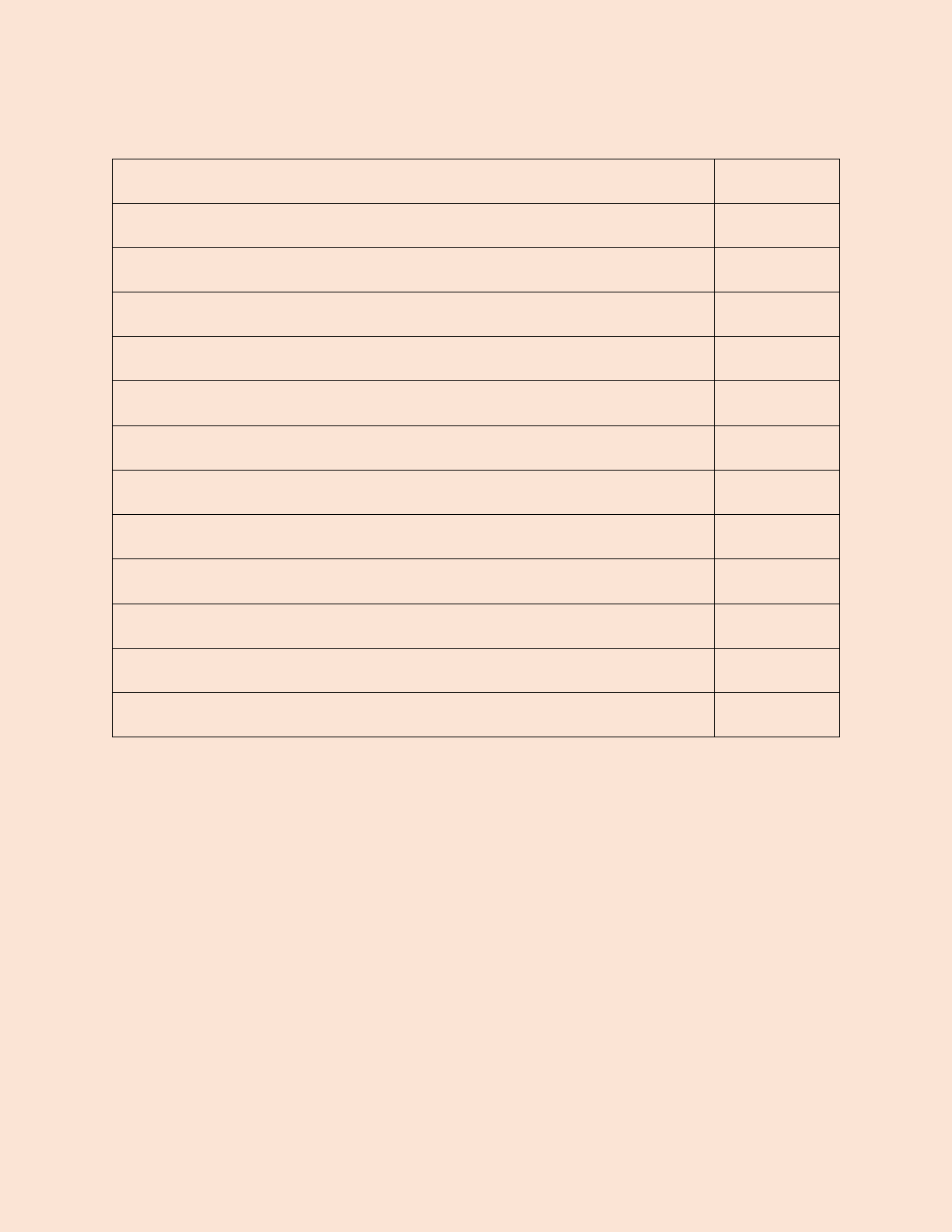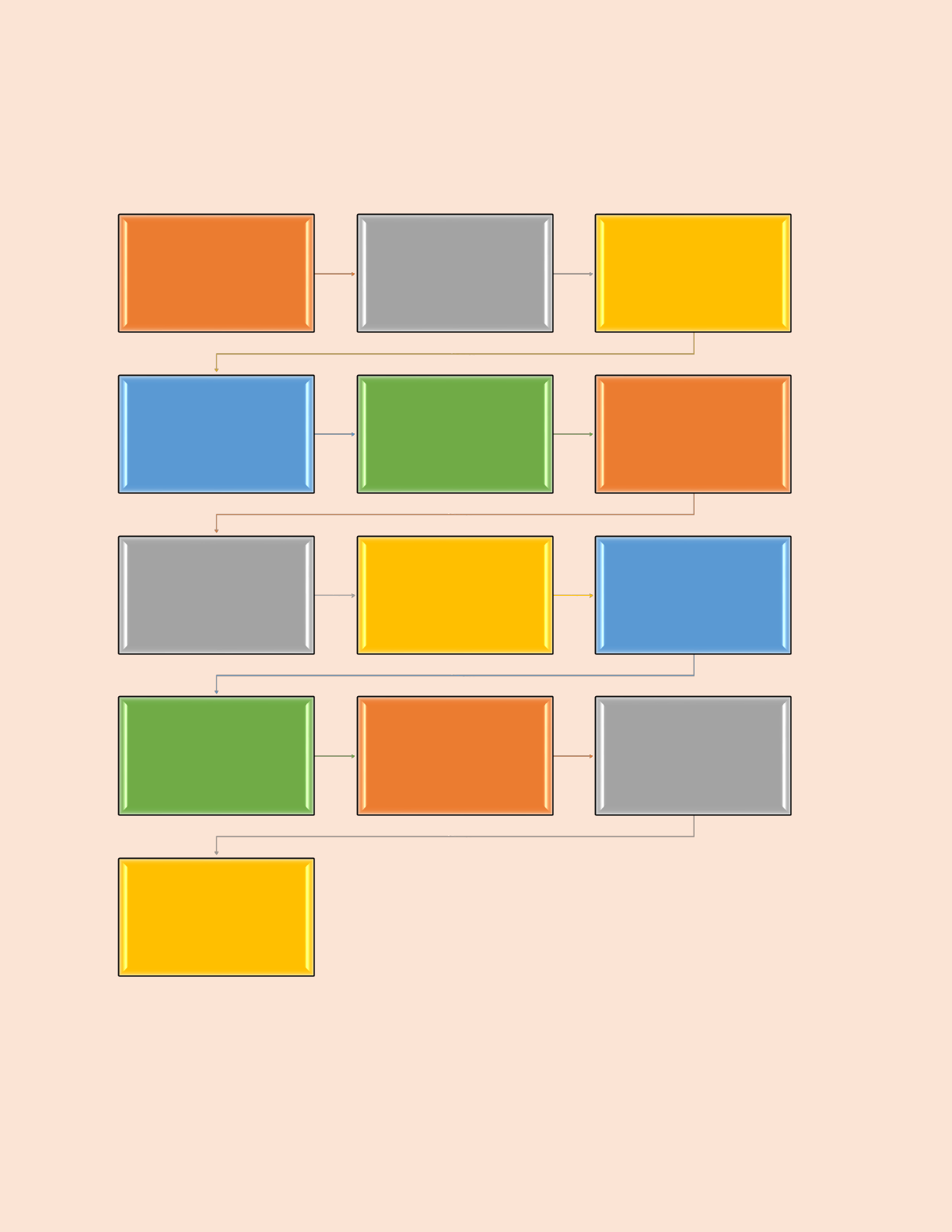
~ 1 ~
School
Newspaper
Guide

~ 2 ~
Table of Contents
Suggested Set of Procedures
3
Jargon (Vocabulary)
4
Become a Journalistic (Student Roles)
6
Brainstorm Article Ideas
8
Details Checklist
10
Newspaper Formatting
11
Institute an Awards Program
12
Journalistic Style
13
Inverted Pyramid Style of News Reporting
15
Editorial Style
16
Organizing an Editorial
17
Interviewing
18
Interview Icebreaker
19

~ 3 ~
Suggested Set of Procedures
Introduction
(Introduce Project
to Students)
Students Learn
Jargon
Delegate Roles
Brainstorm Article
Ideas
Discuss Awards
Discuss Writing
Styles
Students Confirm
Article Topics with
Teacher
Students Write
Articles
Editor(s) Review
Articles and Offer
Critique
Students Submit
Final Draft
Teacher Approves
Final Draft
Graphic Designers
Organize Final
Paper
Teacher Provides
Final Approval

~ 4 ~
Jargon (Vocabulary)
Students will enjoy learning the jargon of the newspaper industry. Many of the terms found in
the fool-lowing glossary are important for your staff to learn. Make copies of the glossary to
distribute to everyone working on the newspaper and encourage students to use appropriate
terminology as often as possible.
Angle
The focus of a story; the approach a
reporter takes to giving the facts.
Column
A regular series of articles or features in A
newspaper. Also, the vertical sections of
printed newspaper matter.
Byline
The line identifying the writer of a
newspaper article.
Caption
(also called cutline) an explanation of a
photo, drawing, or graph.
Classified ads
Small ads for goods or services normally
listed by category.
Columnist
Staff writer who does a regular feature or
article.
Copy
Text of an article
Correspondent
Someone who contributes regularly to a
newspaper, often from outside the
immediate area.
Dateline
The line at the beginning of a story naming
the city or place of origin and often including
the date.
Departments
Regular areas of news covered in a
newspaper.
Display Ad
An ad that contains graphics as well as
copy.
Edit
To make changes to an article for a variety
of reasons: clarity, length, mechanics, and
so on.
Editor
Person who manages the various sections
of the newspaper. This person may also
make editorial decisions regarding content,
length, or mechanics. The editor in chief
manages the entire newspaper.
Exclusive
An article based on information granted to
one news reporter or newspaper.
Features
Stories about people and their lives rather
than news-related facts. Sometimes called
soft news.
Font
Style of type used in a publication.

~ 5 ~
Graphics
art, photography, charts, graphs, and other
design features in a publication.
Editorial
An article on a timely issue that expresses
the opinion of the writer.
Evergreen story
A story, usually a feature, that can be used
at any time because it is not tied into a news
angle.
Hard news
straight news, including all the facts.
Headline
Title of a news article.
Interview
A meeting in person or by phone in which a
reporter asks questions in order to get
information for a story.
Inverted pyramid style
The practice of placing the most important
news information at the beginning of an
article and proceeding through remaining
details in order of importance. Most hard
news is written in this style, which allows the
reader to scan headlines and proceed to
read as much information as is interesting
or necessary.
Layout
The overall design of a publication,
including placement of headlines, articles,
and graphics.
Lead paragraph or sentence
the first sentence or paragraph in an article.
It sets the tone for the article and hopefully
entices the audience to read on.
Libel
The act of damaging someone's reputation
by what has been printed or written.
Masthead
Title of the newspaper and other important
publication facts.
Media
All forms of getting information to the public,
including print, broadcast, and online.
News tip
Information a reporter receives that helps in
the finding or writing of a news story.
Obituary
A notice about a person's death.
Publisher
Often the owner of the newspaper, who
usually has overall responsibility for
finances and editorial decisions. In schools
this would probably be the teacher or
advisor.
Putting the paper to bed
When the paper is ready for printing.
Retraction
A notice in a newspaper that cites an error
the paper has made and is now correcting
or retracting.

~ 6 ~
Become a Journalistic (Student Roles)
Editor in Chief (must have one)
This student oversees the entire
newspaper. Their job is to see that all
deadlines are met and that the paper goes
to press on time. They also make editorial
decisions when articles need to be
shortened or cut altogether.
Assistant Editor
You may wish to have another student act
as assistant. This provides great on-the-job
training for future editors in chief.
Graphic Designer (must have one or two)
This is a job for one or two students, who
oversee the organization & look of the entire
paper.
News Editor (only for classes with 20+
students)
This is the student in charge of the "hard"
news section, as opposed to features. This
may include both school and community
news, such as class elections or a
community zoning issue. This student will
assign articles to news reporters and
establish deadlines for those articles. He or
she may also do some editing on those
articles.
Feature Editor (only for classes with 20+
students)
This student oversees the "soft" news
section. This may include both school and
appropriate community news, such as social
events and interviews. This student will
assign articles to feature reporters and
establish deadlines for those articles. He or
she may also do some editing on those
articles.
Sports Editor
This student or students (you may wish to
have a girl and a boy if there is a great deal
to cover) will write and edit sports news.
There is rarely a need for more than two
students on the sports staff.
Tracking Manager
This student keeps track of what was
covered in each issue so that the same
teacher is not written up three times while
someone else is never mentioned. This
student would have a writing job as well.
Circulation Manager (not required during
remote learning)
This student keeps track of subscriptions
and sees that papers are distributed when
they arrive from the printer. This includes
deliveries to classrooms.
Reviewers of Books, Restaurants, etc.
One or two students may review a variety of
media or a local restaurant for each issue of
the newspaper. Remind them that they are
writing an opinion piece and should follow
the rules for editorial writing.
Advertising Manager
This is the student who receives classified
ads, edits them for content and
completeness, and organizes them for the
newspaper. Students may advertise clubs,
activities, etc. The advertising manager
must reach out to interested parties and
request advertisements pieces from them.
Roving Reporter
This student chooses an interesting,
relevant question on which there may be
many opinions and obtains those opinions

~ 7 ~
from as many people as possible for his or
her column.
Reporters
These students, while not in management
positions, are assigned to write for certain
sections of the newspaper, including the
advice column, lost, and found, and so on.
Art Creator
These students are responsible for drawing
original art where needed or desired.

~ 8 ~
Brainstorm Article Ideas
Class News
You may wish to have a student from each
class or grade level send their news to your
paper. Alternatively, students can be
assigned to cover classes or grade levels.
Editorials
Students may choose to write on kid-
oriented topics or on more global issues.
A Word From the Principal.
Invite the principal or another administrator
to contribute a column about school
happenings.
People Behind the Scenes
Students may enjoy writing features on your
school's unsung heroes, such as
secretaries, maintenance staff,
administrators, volunteers, etc..
School Clubs
Consider covering special club events or
activities in your newspaper.
Calendar of Events
You may wish to include a monthly calendar
of school-wide events. Although these
schedules often change at the last minute,
publishing early notice is often helpful.
Sports
In addition to coverage of interscholastic
competitions, sports news might include
notes from the physical-education teachers
on what is happening in various classes,
information on specific students and their
athletic accomplishments, and coverage of
league sports in the community.
Subject News
This would include news on special events
in particular subject areas that may not be
included in class news, such as a science
fair or international festival that everyone
will be invited to attend.
Restaurant/Book/Software Reviews
These reviews are always an interesting
and popular feature.
Interviews
Subjects can be teachers, administrators,
students, or community members. Be sure
to include photos and follow guidelines for
procedure and protocol before going out for
interviews. Some interviewees may be
willing to provide baby or school pictures to
accompany their interviews.
Kids in the News
If there are students involved in interesting
activities outside of school or who have
accomplished something out-of-the-
ordinary, you may wish to write about their
activities for the newspaper.
Advice Column
Invite letters from readers asking for advice
on certain issues. Letters may be written
anonymously if you prefer. Answers can
come from students, teachers, or school
staff.
Hobby Column
Invite experts to write about how to get
started in a new hobby. Old favorites might
include sports-card collecting, model
building, and stamp collecting. New ideas
could include collecting autographs,
postcards, or arrowheads; origami; cooking;
and kite building.

~ 9 ~
Study Skills How-to
Advice from kids and teachers on making
the most of your time. Topics might include
study habits, how to scan a book, how to
make an outline, and how to prioritize.
Places to Visit in the Community
What is there to see and do in your school’s
local area? Provide descriptions of places
that might be linked to courses of study in
your school or that are just-for-fun family
places. Include prices, telephone numbers,
and other important information.
Consumer Testing
Reporters can test and compare things such
as bubble gum, sneakers, video games, or
any other category of product that students
express interest in. Be sure to follow
procedures for product testing so that tests
are consistent, and results are fair.
Games and Puzzles
Consider including crosswords,
wordsearches, and similar activities in each
issue. Activities may be theme related.
There is excellent software available to help
students design this type of thing.
Did You Know?
These are short bits that include interesting,
little-known facts about the school,
community, or familiar people.
Guest Forum
Consider soliciting features, editorials, or
inspirational pieces from friends, parents,
and supporters of your school. Perhaps
local writers or journalists would be willing to
send short articles.
Classifieds
This section includes ads contributed by
people in the school who have things to give
away or trade. Alternatively, students can
promote their clubs using classified ads.
There is no charge for this advertising.
Jokes
There is never a shortage of material for this
column. Students can write original jokes as
well as recycling old ones.
A Day in the Life of...
Reporters may enjoy spending a day with a
teacher, administrator, staff member, or
another student and writing an article about
the experience.
Guess Who?
This is a contest with clues to the identity of
a student, teacher, or other staff member.
Try to offer a prize to the first successful
respondent.
Roving Reporter
In this section a reporter asks one
opinionated question to several people from
all areas of the school. The question should
be one of general interest.

~ 10 ~
Name: Details Checklist
Article:
Issue Date:
Who?
Details:
What?
Details:
Where?
Details:
When?
Details:
Why and/or how?
Details:
Notes:

~ 11 ~
Newspaper Formatting
1. All copies should be single-spaced.
2. Include three possible headlines to present to your Editor in Chief
3. Spell out the numbers ten and under.
4. If your article takes more than one page, type MORE at the bottom of the first page and
on any additional pages.
5. Include details in your article. For example, if you are writing about a class field trip, say
where and when students went, what they saw, what they enjoyed. Get quotes from one
or two students.
6. Place the newspaper issue date on your final copy.
7. Don't editorialize in a news article (write your opinion). If you wish to write an editorial on
an important or interesting issue, see the teacher.
8. Use italics for titles of books, magazines, movies, and other major published works.
9. Use quotation marks around individual article names, chapters in books, and so on.
10. Make sure quotes are used correctly. Always obtain permission to quote someone in
your article. Make sure you have quoted accurately.
11. Interviews should use this format:
Ahmed: What are your favorite things about Carolina Day School?
I like the students and the teachers.
If your interviewee makes only one or two statements and they are used as part of a
news article, use quotation marks.
12. Use a teacher's first and last name the first time it is mentioned in your article. Then, use
Mr, Mrs, or Ms. followed by the teacher’s last name

~ 12 ~
Institute an Awards Program
One way to motivate students to do quality work is to create a program that rewards both
excellence and effort. Do not limit the number of awards that can be earned in each category.
Students might even win two or three awards for one article.
You can print terrific-looking certificates on a laser printer by using a high quality paper
preprinted with an embellished border. This type of paper can be found at large office-supply
stores or print shops or ordered from paper-supply companies. Or you can use plain paper and
create certificates with borders by using programs such as Print Shop Deluxe. Here are some
awards you might consider.
Excellence in News Writing
This is given for a hard news story that
answers the five W’s and makes a great,
gripping read.
Excellence in Feature Writing
This is the same as above, but is given for
features stories more about the “human"
side of the news that are lighter in content
and structure.
Excellence in Editorial Writing
Given for well-written editorials that clearly
define issues and make good cases for
agreement or disagreement.
Excellence in Headline Writing
Given for exceptional headline writing skill
all its own.
Excellence in Lead Writing
Given for compelling first sentences or
paragraphs that grab the attention of the
reader.
Excellence in Page Layout
Given for the aesthetics of how a page
looks including balance of copy to white
space and use of graphics. This award is
only be given to students who do the actual
layout.
Excellence in Article Concept
Sometimes a student has a tremendous
idea, works extremely hard, but still the
article falls short. This award recognizes
that effort.
The Publisher's Prize
Given for extraordinary effort and dedication
to the newspaper publishing experience.
This special award is only given when it is
clearly deserved, and not necessarily after
every issue.

~ 13 ~
Journalistic Style
Most of the writing that you do for your piece will fall into one of two categories:
journalistic style or the editorial style. Journalistic style is used reporting hard news. This style
consistently utilizes at least four of the five W’s: who, what, when, where, why or how in the lead
paragraph. It is important to understand that stating your opinions is not appropriate in this type
of writing. Writing hard news is writing to inform, not writing to persuade. Facts must be stated
clearly and without bias, allowing readers to form their own opinions.
Teaching Ideas
(1) Discuss the five W’s (who, what, when, where, why or how) by supplying students
with short news articles from your city or community newspaper. Challenge pairs of students to
locate each W and mark it in the way you designate, such as by color coding. Tally the results to
see which W’s appear most often. Try to offer selections that present the five W’s in a variety of
ways.
(2) Have students write short news articles about a recent event at school. Invite
volunteers to read their stories aloud and have students note the W’s that are covered. If an
important W is not included, invite students to add a sentence that will rectify the omission.
There will be times when one of the five W’s may be irrelevant, unnecessary, or unobtainable.
Help students learn to discriminate.
(3) Practice news writing by taking your entire class to observe a school event, such as
an assembly program. Each student is to work independently and should be prepared to take
notes and conduct interviews, if appropriate. Return to your classroom and invite students to
write articles on what they have just seen. This is a good time to discuss angles, focus, and
approach of a news story. Volunteers may read their articles and comparative discussions
should follow.
(4) Teach the concept of the inverted pyramid style of writing, using the reprodecibels on
pages. The most important news facts, including the five W’s, come first at the top of the
inverted pyramid. The reporter must prioritize facts and information to correctly utilize the
inverted pyramid, saving the least important (but still interesting) information for the bottom.
Explain that editors must often cut articles to fit them into the allotted space. It is easier to cut
from the end of an article than to go through and edit for importance. The inverted pyramid
approach also allows readers to scan the paper for items of interest and become informed
without reading beyond the first couple of paragraphs. Use photos cut from magazines or
newspapers to practice writing attention-grabbing headlines and lead sentences. Be sure to
remove any captions. Explain that readers often scan a newspaper looking for headlines,
subheads, and lead sentences that pique their interest. Lead sentences may either be written as
straight factual statements incorporating several the five W’s, or students may use an intriguing
statement or question to draw readers into their articles. You may wish to have students try one
of each. For example, "The school cafeteria, which has tried for years to get students to eat
vegetables, is proposing a new nutrition-based plan to get students to eat healthy." Or "On
Wednesday afternoon in the cafeteria at Old Turnpike Middle School, a hungry group of twelve-
year old students were invited to take part in a strange new eating adventure." Encourage
students to share their work. Invite constructive comments from the class.

~ 14 ~
(5) Find examples of news stories that include quotes from pertinent people. Make
overhead transparencies of the articles. Discuss with students why a quote might have been
used rather than a paraphrase. Help them understand how a variety of sentence approaches
adds interest and texture to their writing. Encourage students to practice writing news stories
that alternate between facts and quotes.

~ 15 ~
Name
Date
Inverted Pyramid Style of News Reporting
Reporters often use the inverted pyramid style as a way of assuring presentation of the most
important news at the beginning of an article. This enables readers to grasp the sense of an
article as well as the main facts quickly and easily.
1. What event will you write about?
2.What headline will you use to grab reader attention?
3.List the five W’s of the event in order of importance.
4. Note other interesting details in order of importance.

~ 16 ~
Editorial Style
Use the editorial style when presenting opinions on timely issues, whether school related
or of a more global nature. While it is still appropriate to include some or all the five W’s, you not
limited to these facts when editorializing. You are now writing to persuade. When writing
editorials, it is important to understand that opinions must be supported by facts, and that a
compelling argument is rarely based on emotions alone. If you are looking to change the way
people think, which is usually the reason for an editorial, then you must present a mix of fact
and reasoned opinion.
Teaching Ideas
(1) Discuss with students the difference between fact and opinion. Ask for their
definitions of each and guide them to an understanding of the use of each in editorial writing.
Reiterate that facts alone belong in straight news articles, while well-reasoned opinions
(opinions supported by facts) belong in editorials. Provide articles and editorials from
newspapers (both national, community, and school) and challenge students to find articles
where reporters mix the two.
(2) Provide examples of editorials from local or national newspapers that deal with topics
that students can relate to, such as funding for school sports or arts programs. Invite students to
read the editorial. Conduct a follow-up discussion in which students express their own opinions
on the issue as well as discussing the power of the editorial that was shared. Excellent editorials
always inspire excellent discussion. Poll students to see if any minds were changed by the
editorial. It is important and valuable to provide as many real-life examples of excellent
newspaper work as you can find, whether from local and national newspapers or publications
from other schools.
(3) Have students brainstorm possible editorial topics. Examples might include weekend
homework, school uniforms, standardized testing, wearing hats in school, school-wide discipline
methods, allowances, dress codes, or backpacks in the classroom. Help students decide on one
or two topics that everyone has strong feelings about. Be sure they understand that it is
important that editorials "speak" to many people, no matter how those people feel about the
issue. Editorials on obscure topics that impact only a few people carry little weight. With limited
space available, only editorials on topics of widespread interest will end up in print.

~ 17 ~
Name
Date
Organizing an Editorial
Effective, compelling editorials are well-organized, succinct, and powerful. Organize your
thoughts by answering the questions below.
1. What issue will I write about?
2.What headline will I use to draw attention to your editorial?
3.What is my opinion on the issue?
4.What are three reasons for my opinion?
5. What are two reasons why someone might disagree?
6.Write the lead for your editorial.
7. On a separate sheet of paper, write your editorial using the information you have organized
on this worksheet. When you have completed the editorial, use the checklist below to edit your
work. Clearly stated at least once.
I have provided at least three reasons for my opinion.
I have supported my reasons with facts when possible.
I have demonstrated understanding of the opposing point of view.
I have written an appropriate headline.
I have signed my work.

~ 18 ~
Interviewing
The ability to conduct a good interview is a skill that will benefit you in a variety of areas.
Every reporter should know how it has done. Editors may choose to run a feature interview with
a faculty member or student each month. Or interviews may simply provide quotes for regular
news, sports, and feature articles. Students should practice interviewing techniques with each
other before going out on assignment.
Interviewing Tips
Make an appointment well in advance of your interview. Introduce yourself, mention
that you are a reporter for your school's newspaper, explain why you would like an interview,
use please and thank you. Then, show up five minutes early.
Go to the interview prepared. Take your notebook and at least two pencils or pens.
Take a device to record with only if you have asked permission in advance. Have at least ten
questions prepared. Keep in mind the five W’s of news reporting. Avoid questions that require
only yes or no answers.
• Ask your subject to spell any names you are unsure of.
• Take careful notes. If you plan to quote your subject, make sure you have the quote
word-for-word. Recorders come in handy here.
• Offer to bring the first or second draft to your subject for approval.
• Leave your contact information with the person you are interviewing. Thank your
subject for his or her time before leaving.
Students may try to run the questions and answers word-for-word as their entire story.
While on occasion this has its place, it is preferable and far more interesting to turn the
questions and answers into a narrative and alternate between facts, quotes, and statements.
For example, instead of writing Q: When did you become interested in photography? A: When
my uncle gave me a camera. I was about five years old, a reporter could write, Annie became
interested in photography at age five, when her uncle gave her a camera.

~ 19 ~
Name:
Date:
Interviewee:
Interview Icebreaker
Who
has influenced you most?
is your favorite teacher?
is your hero?
Would you most like to meet?
What
favorite book?
favorite subject in school?
Favorite sport or hobby?
career choice? Pet peeve?
When
were you the happiest?
Were you the saddest?
is your birthday?
Where
did you grow up?
would you like to visit?
did you spend your best vacation overshowed are you?
How
Would you describe yourself, using three adjectives?
Would you spend your ideal day?
Will you want to be remembered?

~ 20 ~
Why to any of the above questions
